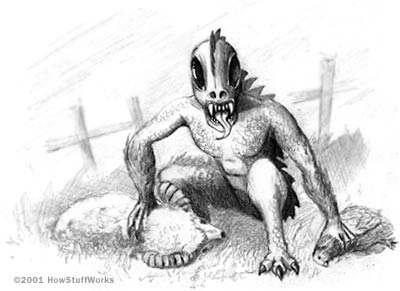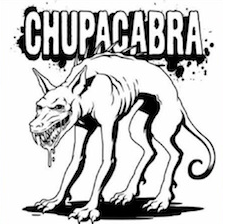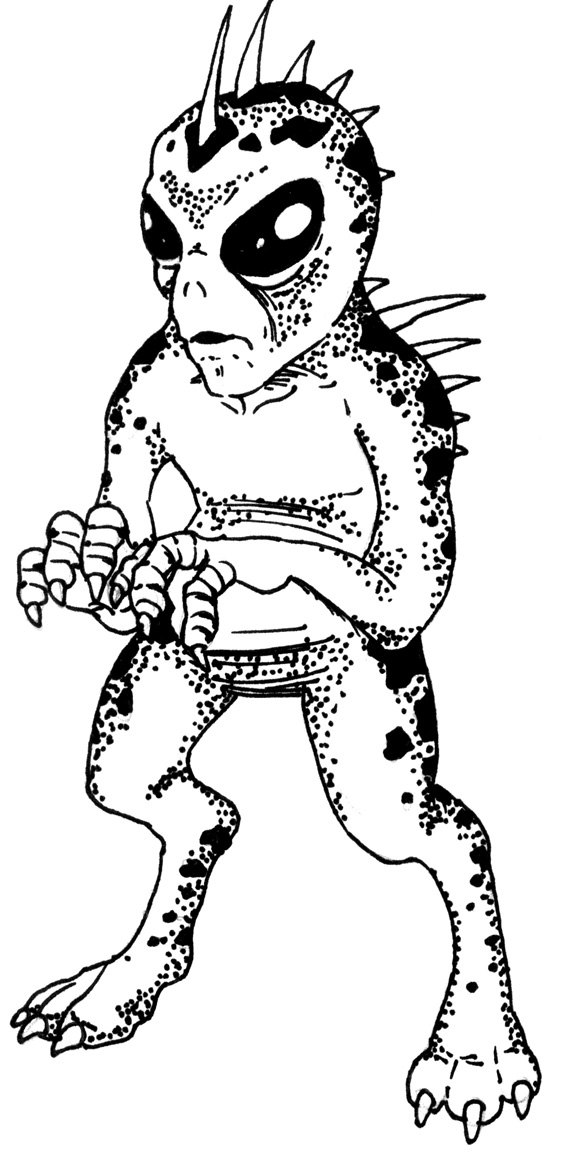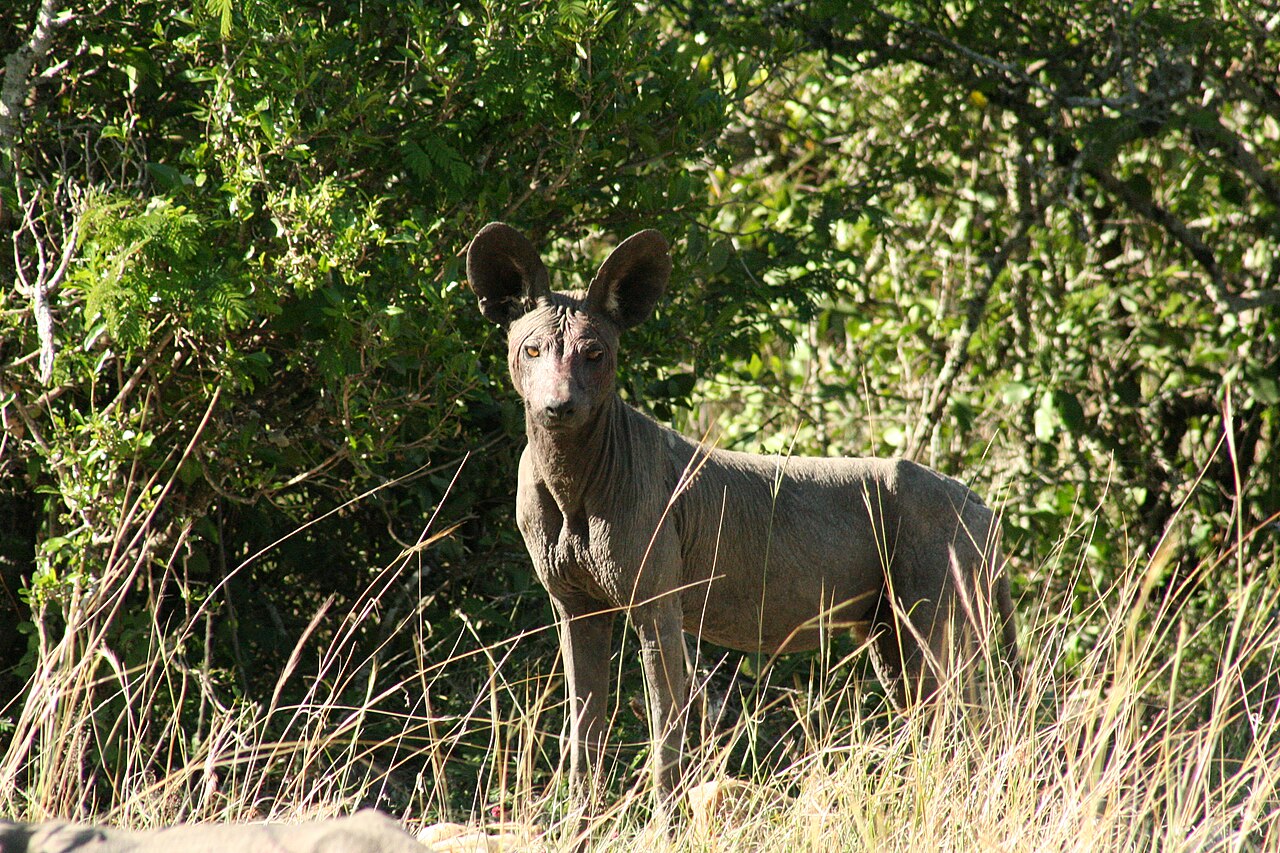

チュパカブラ
Chupacabra
☆
チュパカブラ(chupacabra,
スペイン語発音:[tʃupaˈkaβɾas]、文字通り「ヤギ吸い」を意味する。スペイン語のchupa「吸う」とcabras「ヤギ」に由来)は、ア
メリカ大陸の一部地域に伝わる伝説上の生物、あるいは未確認生物である。この名は、その吸血行為に由来する。チュパカブラは家畜、特に山羊を襲い、その血
を吸うと言われる。
その外見描写は地域によって異なる。プエルトリコやヒスパニック系アメリカでは、小型の熊ほどの大きさの重厚な生物で、爬虫類的かつ異星人のような特徴を
持ち、首から尾の付け根まで棘の列が走っていると一般に説明される。一方、アメリカ南西部ではより犬に似た姿で描かれる。
最初の目撃情報とそれに伴う記述は1995年にプエルトリコで初めて報告された。その後、この生物は北はメイン州、南はチリ、さらにはアメリカ大陸外のロ
シアやフィリピンなどの国々でも報告されている。しかし、これらの報告は全て伝聞に基づくものであり、裏付けがない、あるいは証拠が不十分として無視され
てきた。メキシコ北部とアメリカ南部の目撃例は、疥癬に罹患したイヌ科動物であることが確認されている。[1][2]
| The chupacabra or
chupacabras (Spanish pronunciation: [tʃupaˈkaβɾas], literally
'goat-sucker', from Spanish: chupa, 'sucks', and cabras, 'goats') is a
legendary creature, or cryptid, in the folklore of parts of the
Americas. The name comes from the animal's purported vampirism – the
chupacabra is said to attack and drink the blood of livestock,
including goats. Physical descriptions of the creature vary. In Puerto Rico and in Hispanic America it is generally described as a heavy creature, reptilian and alien-like, roughly the size of a small bear, and with a row of spines reaching from the neck to the base of the tail, while in the Southwestern United States it is depicted as more dog-like. Initial sightings and accompanying descriptions first occurred in Puerto Rico in 1995. The creature has since been reported as far north as Maine, as far south as Chile, and even outside the Americas in countries like Russia and the Philippines. All of the reports are anecdotal and have been disregarded as uncorroborated or lacking evidence. Sightings in northern Mexico and the Southern United States have been verified as canids afflicted by mange.[1][2] |
チュパカブラ(スペイン語発音:[tʃupaˈkaβɾas]、文字通
り「ヤギ吸い」を意味する。スペイン語のchupa「吸う」とcabras「ヤギ」に由来)は、アメリカ大陸の一部地域に伝わる伝説上の生物、あるいは未
確認生物である。この名は、その吸血行為に由来する。チュパカブラは家畜、特に山羊を襲い、その血を吸うと言われる。 その外見描写は地域によって異なる。プエルトリコやヒスパニック系アメリカでは、小型の熊ほどの大きさの重厚な生物で、爬虫類的かつ異星人のような特徴を 持ち、首から尾の付け根まで棘の列が走っていると一般に説明される。一方、アメリカ南西部ではより犬に似た姿で描かれる。 最初の目撃情報とそれに伴う記述は1995年にプエルトリコで初めて報告された。その後、この生物は北はメイン州、南はチリ、さらにはアメリカ大陸外のロ シアやフィリピンなどの国々でも報告されている。しかし、これらの報告は全て伝聞に基づくものであり、裏付けがない、あるいは証拠が不十分として無視され てきた。メキシコ北部とアメリカ南部の目撃例は、疥癬に罹患したイヌ科動物であることが確認されている。[1][2] |
| Name Chupacabras can be literally translated as 'goat-sucker', from chupar ('to suck') and cabras ('goats'). It is known as both chupacabras and chupacabra throughout the Americas, with the former being the original name,[3] and the latter a regularization. The name is attributed to Puerto Rican comedian Silverio Pérez, who coined the label in 1995 while commenting on the attacks as a San Juan radio deejay.[4][5] |
名称 チュパカブラは文字通り「ヤギを吸う者」と訳せる。chupar(吸う)とcabras(ヤギ)から成る。アメリカ大陸全域でチュパカブラとチュパカブラ の両方で知られており、前者が本来の名称[3]、後者が正規化された呼称である。この名称はプエルトリコのコメディアン、シルベリオ・ペレスに由来する。 彼は1995年、サンフアンのラジオDJとして襲撃事件を解説中にこの呼称を考案した[4][5]。 |
| History In 1975, a series of livestock killings in the small town of Moca, Puerto Rico were attributed to el vampiro de Moca ('the vampire of Moca').[6] Initially, it was suspected that the killings were committed by a Satanic cult; later more killings were reported around the island, and many farms reported loss of animal life. Each of the animals was reported to have had its body bled dry through a series of small circular incisions.  Graphic depiction of Chupacabra, as described by Puerto Rican witnesses in 1995 The first reported attack eventually attributed to the actual chupacabras occurred in March 1995. Eight sheep were discovered dead in Puerto Rico, each with three puncture wounds in the chest area and reportedly completely drained of blood.[7] A few months later, in August, an eyewitness named Madelyne Tolentino reported seeing the creature in the Puerto Rican town of Canóvanas, where as many as 150 farm animals and pets were reportedly killed.[7] Puerto Rican comedian and entrepreneur Silverio Pérez is credited with coining the term chupacabras soon after the first incidents were reported in the press. Shortly after the first reported incidents in Puerto Rico, other animal deaths were reported in other countries, such as Argentina, Bolivia, Brazil, Chile, Colombia, Dominican Republic, El Salvador, Honduras, Mexico, Nicaragua, Panama, Peru, and the United States.[7] In 2019 a video recorded by Mundo Ovni showed the results of a supposed attack on chickens in the Seburuquillo sector of Lares, Puerto Rico.[8] |
歴史 1975年、プエルトリコの小さな町モカで発生した一連の家畜殺害事件は、「モカの吸血鬼」の仕業とされた。[6] 当初、この殺害は悪魔崇拝のカルトによるものと疑われたが、その後島内でさらに多くの殺害が報告され、多くの農場で家畜の死が確認された。各動物は、一連 の小さな円形の切開から体内の血液を完全に抜かれた状態で発見されたと報告されている。  1995年にプエルトリコの目撃者が描写したチュパカブラの図解 実際のチュパカブラによる最初の襲撃報告は1995年3月に発生した。プエルトリコで8頭の羊が死亡状態で発見され、各羊の胸部には3つの刺し傷があり、 血液が完全に抜かれていたと報告されている。[7] 数か月後の8月、マデリン・トレントという目撃者がプエルトリコの町カノバナスでこの生物を目撃したと報告した。同地では最大150頭の家畜やペットが殺 害されたと伝えられている。[7] プエルトリコのコメディアン兼実業家シルベリオ・ペレスは、最初の事件が報道された直後に「チュパカブラ」という用語を考案したとされている。プエルトリ コでの最初の事件報告後まもなく、アルゼンチン、ボリビア、ブラジル、チリ、コロンビア、ドミニカ共和国、エルサルバドル、ホンジュラス、メキシコ、ニカ ラグア、パナマ、ペルー、アメリカ合衆国など、他の国々でも動物の死が報告された。[7] 2019年、ムンド・オヴニが撮影した動画は、プエルトリコ・ラレスのセブルキージョ地区で鶏が襲われたとされる結果を示していた。[8] |
| Reputed origin A five-year investigation by Benjamin Radford, documented in his 2011 book Tracking the Chupacabra, concluded that the description given by the original eyewitness in Puerto Rico, Madelyne Tolentino, was based on the creature Sil in the 1995 science-fiction horror film Species.[1] The alien creature Sil is nearly identical to Tolentino's chupacabra eyewitness account and she had seen the movie before her report: "It was a creature that looked like the chupacabra, with spines on its back and all... The resemblance to the chupacabra was really impressive", Tolentino reported.[9] Radford revealed that Tolentino "believed that the creatures and events she saw in Species were happening in reality in Puerto Rico at the time", and therefore concludes that "the most important chupacabra description cannot be trusted".[1] This, Radford believes, seriously undermines the credibility of the chupacabra as a real animal.[10] The reports of blood-sucking by the chupacabra were never confirmed by a necropsy,[1] the only way to conclude that the animal was drained of blood. Dr. David Morales, a Puerto Rican veterinarian with the Department of Agriculture, analyzed 300 reported victims of the chupacabra and found that they had not been bled dry.[1] Radford divided the chupacabra reports into two categories: the reports from Puerto Rico and Latin America, where animals were attacked and it is supposed their blood was extracted; and the reports in the United States of mammals, mostly dogs and coyotes with mange, that people call "chupacabra" due to their unusual appearance.[11] In 2010, University of Michigan biologist Barry O'Connor concluded that all the chupacabra reports in the United States were simply coyotes infected with the parasite Sarcoptes scabiei, whose symptoms would explain most of the features of the chupacabra: they would be left with little fur, thickened skin, and a rank odor. O'Connor theorized that the attacks on goats occurred "because these animals are greatly weakened, [so] they're going to have a hard time hunting. So they may be forced into attacking livestock because it's easier than running down a rabbit or a deer."[12][1] Both dogs and coyotes can kill and not consume the prey, either because they are inexperienced, or due to injury or difficulty in killing the prey.[1][13] The prey can survive the attack and die afterwards from internal bleeding or circulatory shock.[1][13] The presence of two holes in the neck, corresponding with the canine teeth, are to be expected since this is the only way that most land carnivores have to catch their prey.[1] There are reports of stray Mexican hairless dogs being mistaken for chupacabras.[14] |
伝承上の起源 ベンジャミン・ラドフォードによる5年間の調査は、2011年の著書『チュパカブラを追って』で記録されている。その調査は、プエルトリコの最初の目撃者 マデリン・トレントが語った生物の描写が、1995年のSFホラー映画『スペシズ』に登場する生物シルに基づいていると結論づけた。[1] 宇宙生物シルはトレントーニョの目撃証言とほぼ一致し、彼女は報告前に同映画を観ていた:「背中に棘が生えた姿はチュパカブラそのものだった… チュパカブラとの類似性は本当に印象的だった」とトレンティーノは報告している。[9] ラドフォードは、トレンティーノが「当時プエルトリコで現実的に起きていると信じていた」と明かし、したがって「最も重要なチュパカブラの描写は信用でき ない」と結論づけた。[1] ラドフォードは、これがチュパカブラが実在する動物であるという信頼性を深刻に損なうと考えている。[10] チュパカブラによる吸血の報告は、解剖検査によって確認されたことは一度もない[1]。解剖検査こそが、動物の血が抜かれたと結論付ける唯一の方法であ る。プエルトリコ農務省の獣医師であるデイビッド・モラレス博士は、チュパカブラの被害者と報告された300体の死体を分析したが、それらが血を完全に抜 かれていた証拠は見つからなかった。[1] ラドフォードはチュパカブラの報告を二種類に分類した。一つはプエルトリコやラテンアメリカでの報告で、動物が襲われ血液を吸われたとされるもの。もう一 つはアメリカ合衆国での報告で、主に疥癬にかかった犬やコヨーテといった哺乳類が、その異様な外見から人々に「チュパカブラ」と呼ばれているケースだ。 [11] 2010年、ミシガン大学の生物学者バリー・オコナーは、米国におけるチュパカブラ報告の全てが、単にサコプテス・スカビエイという寄生虫に感染したコ ヨーテであると結論付けた。この寄生虫の症状はチュパカブラの特徴の大半を説明できる:毛がほとんどなくなり、皮膚が厚くなり、悪臭を放つ状態になるの だ。オコナーは、ヤギへの襲撃は「これらの動物が著しく衰弱しているため、狩りが困難になる。そのためウサギやシカを追いかけるより容易な家畜への攻撃を 余儀なくされる」と推測した[12][1]。犬もコヨーテも、未熟さや負傷、獲物の殺傷困難さから、獲物を殺害しても食さないことがある。[1][13] 獲物は攻撃を生き延びた後、内出血や循環性ショックで死ぬこともある。[1][13] 首に犬歯に対応する2つの穴があるのは、ほとんどの陸生肉食動物が獲物を捕らえる唯一の方法だから当然だ。[1] 迷い込んだメキシコハゲ犬がチュパカブラと間違えられたという報告もある。[14] |
Appearance Mange can often greatly alter the expected appearance of an animal. Wild and domestic canines with severe cases of mange have been proposed as explanations for the Chupacabra.(However, this is wildlife photographed in Tanzania, not a sick animal.) The most common description of the chupacabra is that of a reptile-like creature, said to have leathery or scaly greenish-gray skin and sharp spines or quills running down its back.[15] It is said to be approximately 3 to 4 feet (0.9 to 1.2 m) high, and stands and hops in a fashion similar to that of a kangaroo.[16] This description was the chief one given to the few Puerto Rican reports in 1995 that claimed to have sighted the creature, with similar reports in parts of Chile and Argentina following.[1] Another common description of the chupacabra is of a strange breed of wild dog. This form is mostly hairless and has a pronounced spinal ridge, unusually pronounced eye sockets, fangs, and claws. This description started to appear in the early 2000s from reports trailing north from the Yucatán Peninsula, northern Mexico, and then into the United States; becoming the predominant description since.[1] Unlike conventional predators, the chupacabra is said to drain all of the animal's blood (and sometimes organs) usually through three holes in the shape of a downwards-pointing triangle, but sometimes through only one or two holes.[17] |
外観 疥癬はしばしば動物の外観を大きく変えることがある。重度の疥癬に罹った野生および家畜のイヌ科動物が、チュパカブラの説明として提案されてきた。(ただ し、これはタンザニアで撮られた野生動物であり、病気の動物ではない。) チュパカブラの最も一般的な描写は爬虫類のような生物であり、革のような、あるいは鱗状の緑がかった灰色の皮膚を持ち、背中に鋭い棘や針が走っていると言 われる。[15] 体高は約3~4フィート(0.9~1.2メートル)で、カンガルーに似た姿勢で立ち、跳躍すると言われる。[16] この描写は、1995年にこの生物を目撃したと主張するプエルトリコの少数の報告で主に用いられ、その後チリやアルゼンチンの一部でも同様の報告が続い た。[1] チュパカブラのもう一つの一般的な描写は、奇妙な野生の犬種であるというものだ。この形態はほぼ無毛で、顕著な背骨の隆起、異常に深い眼窩、牙、そして爪 を持つ。この描写は2000年代初頭、ユカタン半島からメキシコ北部を経てアメリカ合衆国へと北上する報告から現れ始め、それ以来主流の描写となってい る。[1] 従来の捕食者とは異なり、チュパカブラは通常、下向きの三角形を描く3つの穴から、時には1つか2つの穴から、獲物の血液(時には臓器も)を全て吸い取る といわれている。[17] |
| Plausibility of existence The chupacabra panic first started in late 1995, Puerto Rico: farmers were mass reporting the mysterious killings of various livestock. In these reports, the farmers recalled two puncture wounds on the animal carcasses.[1] Chupacabra killings were soon associated with a seemingly untouched animal carcass other than puncture wounds which were said to be used to suck the blood out of the victim. Reports of such killings began to spread around and eventually out of the country, reaching areas such as Mexico, Brazil, Chile, and the Southern area of the United States. Most notably, these areas experience frequent, and extreme dry seasons; in the cases of the Puerto Rican reports of 1995 and the Mexican reports of 1996, both countries were currently experiencing or dealing with the aftermath of severe droughts. Investigations carried out in both countries at this time noted a certain dramatic violence in these killings.[18] These environmental conditions could provide a simple explanation for the livestock killings: wild predators losing their usual prey to the drought, therefore being forced to hunt the livestock of farmers for sustenance. Thus, the same theory can be applied to many of the other 'chupacabra' attacks: that the dry weather had created a more competitive environment for native predators, leading them to prey on livestock to survive. Such an idea can also explain the increased violence in the killings; hungry and desperate predators are driven to hunt livestock to avoid starvation, causing an increase in both the number of livestock killings, and the viciousness of each one. Evidence of such is provided in page 179 of Benjamin Radford's book, Tracking the Chupacabra: The Vampire Beast in Fact, Fiction, and Folklore. Radford's chart highlights ten significant reports of chupacabra attacks, seven of which had a carcass recovered and examined; these autopsies concluded the causes of death as various animal attacks, as displayed though the animal DNA found on the carcasses.[1] Radford provides further evidence in pages 161-162 of his book, displaying animals who are proven to have fallen victim to regular coyote attacks; thus, explaining that it is not unusual for an animal carcass to be left uneaten while only displaying puncture wounds and/or minimal signs of attack.[1] The plausibility of the chupacabra's existence is also discredited by the varying descriptions of the creature. Depending on the reported sighting, the creature is described with thick skin or fur, wings or no wings, a long tail or no tail, is bat-like, dog-like, or even alien-like.[1] Evidently, the chupacabra has a wide variety of descriptions; to the point where it is hard to believe that all the sightings are of the same creature. A very likely explanation for this phenomenon is that individuals who had heard of the newly popular chupacabra had the creature's name fresh in their mind before they happened to see a strange looking animal. They then resort to make sense of their encounter by labelling it as the recently 'discovered' monster, instead of a more realistic explanation. For example, some scientists hypothesize that what many believe to be a chupacabra is a wild or domestic dog affected by mange, a disease causing a thick buildup of skin and hair loss.[19] |
存在の可能性 チュパカブラ騒動は1995年末、プエルトリコで始まった。農家が家畜の不可解な死を相次いで報告したのだ。報告によれば、死骸には二か所の刺し傷があっ た[1]。チュパカブラによる殺害は、刺し傷以外の損傷がほとんど見られない死骸と結びつけられるようになった。この刺し傷は犠牲者の血を吸うために使わ れたと言われる。こうした殺害の報告は周辺地域に広がり、やがて国外へも伝播。メキシコ、ブラジル、チリ、アメリカ南部などの地域にまで到達した。 特に注目すべきは、これらの地域が頻繁かつ極端な乾季を経験している点だ。1995年のプエルトリコ報告と1996年のメキシコ報告の事例では、両国とも 深刻な干ばつを経験中か、その余波に対処中だった。当時両国で行われた調査では、これらの殺害に特定の劇的な暴力性が認められた[18]。こうした環境条 件は家畜殺害の単純な説明となり得る:野生捕食者が干ばつで通常の獲物を失い、生存のために農家の家畜を狩らざるを得なくなったのだ。したがって、同様の 理論は他の多くの「チュパカブラ」襲撃事例にも適用できる。すなわち、乾燥した気候が在来捕食者にとってより競争の激しい環境を生み出し、生存のために家 畜を捕食するようになったという説である。この考え方は殺害の暴力性の増加も説明できる。飢えと絶望に駆られた捕食者は餓死を避けるため家畜を狩り、その 結果、家畜殺害の件数と各事件の凶暴性の両方が増加したのである。 この証拠はベンジャミン・ラドフォード著『チュパカブラを追う:吸血獣の現実・虚構・伝承』(Tracking the Chupacabra: The Vampire Beast in Fact, Fiction, and Folklore)179ページに示されている。ラドフォードの表はチュパカブラ襲撃の重要事例10件を列挙し、うち7件では死体が回収・検査された。こ れらの解剖結果では、死因は様々な動物による襲撃と結論づけられており、死体から検出された動物DNAによって裏付けられている。[1] ラドフォードは同書161-162ページでさらなる証拠を提示している。そこではコヨーテによる通常の襲撃の犠牲となったことが証明された動物が示されて おり、死骸が食べ残され、刺し傷や最小限の襲撃痕しか見られないことが珍しいことではないと説明している。[1] チュパカブラの存在可能性は、その生物の描写が様々である点でも否定される。目撃報告によって、その生物は厚い皮膚や毛皮を持つ、翼がある/ない、長い尾 がある/ない、コウモリに似ている、犬に似ている、あるいは宇宙人にすら似ているなどと描写される。[1] 明らかにチュパカブラの描写は多岐にわたり、全ての目撃例が同一生物とは信じがたいほどだ。この現象の最も有力な説明は、新たに流行したチュパカブラの話 を耳にした人々が、奇妙な動物を目撃する前にその名前を鮮明に記憶していたことにある。彼らは遭遇した生物を、現実的な説明ではなく、最近「発見された」 怪物として分類することで理解しようとする。例えば、多くの科学者は、多くの人がチュパカブラと信じているものは、皮膚の肥厚と脱毛を引き起こす病気であ る疥癬に感染した野生の犬や飼い犬である可能性があると推測している。[19] |
| Related legends The "Ozark Howler", a large bear-like animal, is the subject of a similar legend.[20] The Peuchens of Chile also share similarities in their supposed habits, but instead of being dog-like they are described as winged snakes. This legend may have originated from the vampire bat, an animal endemic to the region.[21] In the Philippines the Sigbin shares many of the chupacabra's descriptions. In 2018 there were reports of suspected chupacabras in Manipur, India. Many domestic animals and poultry were killed in a manner similar to other chupacabra attacks, and several people reported that they had seen creatures. Forensic experts opined that street dogs were responsible for mass killing of domestic animals and poultry after studying the remnants of a corpse.[22] |
関連する伝説 「オザーク・ハウラー」と呼ばれる大型の熊のような動物も、同様の伝説の主題となっている。[20] チリのプーチェンも習性において類似点を持つが、犬に似た姿ではなく翼のある蛇と描写される。この伝説は、同地域固有の動物である吸血コウモリに由来する 可能性がある。[21] フィリピンではシグビンがチュパカブラの記述と多くの共通点を持つ。 2018年にはインドのマニプール州でチュパカブラと疑われる生物の目撃報告があった。多くの家畜や家禽が他のチュパカブラ襲撃と同様の手口で殺害され、 複数の人が生物を目撃したと報告した。法医学専門家は死体の残骸を調査した後、家畜や家禽の大量殺害は野良犬によるものだと結論づけた。[22] |
| Media This section needs additional citations for verification. Please help improve this article by adding citations to reliable sources in this section. Unsourced material may be challenged and removed. Find sources: "Chupacabra" – news · newspapers · books · scholar · JSTOR (March 2024) (Learn how and when to remove this message) A chupacabra is referred to in the 2009 novel Drive Your Plow Over the Bones of the Dead. The debut album by Imani Coppola is titled Chupacabra. In Indigenous (2014), the chupacabra is the main antagonist. The myth of the chupacabra is mocked in a 2012 episode of the cartoon series South Park, titled "Jewpacabra", in which antisemitic main character Eric Cartman claims to have seen a Jewish Chupacabra that kills children on Easter.[23] The chupacabra was included as one of several vinyl figurines in Cryptozoic Entertainment's Cryptkins blind box toy line in 2018.[24][25] A redesigned series of figurines, including an updated chupacabra, was released in August 2020.[26] The search for a chupacabra was featured in the 1997 The X-Files episode "El Mundo Gira".[27] "Chupacabra" was the title of the midseason finale of season 4 of the supernatural drama television series Grimm, in December 2014. Teen Titans Academy, a DC Comics book, has a bat-like metahuman called Chupacabra, whose alter ego is Diego Pérez, named in honour of George Pérez (the artist that initially illustrated the Teen Titans).[28] A 1999 episode of Futurama features a monster called "El Chupanibre". In the Jackie Chan Adventures episode "The Curse of El Chupacabra", Jackie Chan's friend El Toro gets scratched and infected by a Chupacabra, causing him to transform into another Chupacabra every night, much like a werewolf. In season 3 of Workaholics called "To Kill a Chupacabraj", Blake finds what he believes to be the deceased corpse of the Rancho Chupacabra in the pool, though it turns out to be the neighbor's dog. In the Netflix original series The Imperfects, the character of Juan Ruiz transforms into a chupacabra whenever anyone he cares about is in danger. The 2016 film La leyenda del Chupacabras features the titular Chupacabra initially as an antagonist before revealing the creature is merely trying to rescue its family. The Brazilian Chupa-Cu legend created in 2017 takes its cues from the chupacabra. A "Chupakabura" plays the role of a tourism mascot for the fictional town of Manoyama in P.A. Works' 2017 anime Sakura Quest. The spelling and pronunciation relates to a retired mascot called "Kabura Kid", whose name was a pun alluding to the Japanese word for turnips.[29] The 2023 film Chupa is about a chupacabra that is saved from scientists who want to capture it to prove it is real and exploit it for medicine. The 2010-2011 Super Sentai series Tensou Sentai Goseiger's main antagonist Brajira of the Messiah assumes the guise Buredoran of the Chupacabra when working with the Yuumajuu, the villain faction of the second arc that is based on cryptids. The Ukrainian news program TSN used to broadcast fake news about the Chupacabra when no interesting news were there to broadcast. In a short titled "Mission: Chupacabras" from Helluva Boss, a Mexican goat-farmer mistakes Blitzo for a chupacabra and tries to sell him. Chupacabra vs. The Alamo, a 2013 made-for-TV movie. Guns of El Chupacabra, a 1997 martial arts based monster film. "Chupacabras," a song by the Welsh band Super Furry Animals from their 1997 album Radiator. |
メディア この節は検証可能な情報源を必要としている。信頼できる情報源をこの節に追加し、記事の改善に協力してほしい。出典のない記述は削除される可能性がある。 出典を探す: 「チュパカブラ」 – ニュース · 新聞 · 書籍 · 学術文献 · JSTOR (2024年3月) (このメッセージを削除する方法と時期について) チュパカブラは、2009年の小説『Drive Your Plow Over the Bones of the Dead』で言及されている。 イマニ・コッポラのデビューアルバムは『Chupacabra』と題されている。 映画『インディジナス』(2014年)では、チュパカブラが主要な敵役として登場する。 チュパカブラの伝説は、2012年のアニメシリーズ『サウスパーク』のエピソード「ユダヤカブラ」で嘲笑されている。このエピソードでは、反ユダヤ主義的 な主人公エリック・カートマンが、イースターに子供を殺すユダヤ人のチュパカブラを見たと言い張る。[23] 2018年、クリプトゾイック・エンターテインメントのブラインドボックス玩具シリーズ「クリプトキンス」に、数種類のビニールフィギュアの一つとして チュパカブラが収録された。[24][25] 2020年8月には、デザインを一新したフィギュアシリーズが発売され、改良版のチュパカブラも含まれていた。[26] チュパカブラの探索は、1997年の『X-ファイル』エピソード「エル・ムンド・ヒラ」で取り上げられた。[27] 「チュパカブラ」は、2014年12月に放送された超自然現象ドラマ『グリム』シーズン4のシーズン中盤フィナーレのタイトルである。 DCコミックスの『ティーン・タイタンズ・アカデミー』には、コウモリのようなメタヒューマン「チュパカブラ」が登場する。その正体はディエゴ・ペレス で、ティーン・タイタンズを最初に描いたアーティスト、ジョージ・ペレスに敬意を表して名付けられた。[28] 1999年の『フューチュラマ』のエピソードには「エル・チュパニブレ」という怪物が登場する。 『ジャッキー・チェン・アドベンチャーズ』のエピソード「エル・チュパカブラの呪い」では、ジャッキー・チェンの友人エル・トロがチュパカブラに引っかか れて感染し、毎晩狼男のように別のチュパカブラへと変身するようになる。 『ワークアホリックス』シーズン3の「チュパカブラを殺す」では、ブレイクがプールでランチョ・チュパカブラの死体と思われるものを見つけるが、実は隣人 の犬だった。 Netflixオリジナルシリーズ『ザ・インパーフェクツ』では、フアン・ルイスというキャラクターが、大切な人が危険にさらされるたびにチュパカブラに 変身する。 2016年の映画『La leyenda del Chupacabras』では、タイトルにもなっているチュパカブラが当初は敵役として登場するが、実は家族を救おうとしているだけだと明らかになる。 2017年に創作されたブラジルの伝説「チュパ・クー」はチュパカブラをモデルにしている。 P.A.ワークス制作の2017年アニメ『サクラクエスト』では、架空の町マノヤマの観光マスコットとして「チュパカブラ」が登場する。この名称と発音 は、カブを意味する日本語にかけて名付けられた引退マスコット「カブラキッド」に由来する。[29] 2023年の映画『チュパ』は、実在を証明し薬用として利用しようと捕獲しようとする科学者から救われるチュパカブラの物語だ。 2010-2011年のスーパー戦隊シリーズ『天装戦隊ゴセイジャー』では、メシアの主敵ブラジラが、第二章の怪獣をモチーフにした悪の勢力「ユウマジュ ウ」と共謀する際、チュパカブラの化身「ブレドラン」となる。 ウクライナのニュース番組TSNは、放送する興味深いニュースがない時、チュパカブラに関する偽ニュースを流していた。 『ヘルバ・ボス』の短編「ミッション:チュパカブラ」では、メキシコのヤギ農家がブリッツォをチュパカブラと間違え、売り飛ばそうとする。 2013年のテレビ映画『チュパカブラ対アラモ』。 1997年の武術ベースの怪獣映画『エル・チュパカブラの銃』。 ウェールズのバンド、スーパー・ファリー・アニマルズの1997年アルバム『ラジエーター』に収録された楽曲「チュパカブラス」。 |
| References 1. Radford, Benjamin (2011). Tracking the Chupacabra: The Vampire Beast in Fact, Fiction and Folklore. UNM Press. ISBN 978-0-8263-5015-2. 2. González Rodríguez, Miried (24 September 2002). "Disfrazado el chupacabras" [Disguised as chupacabras]. Primera Hora (in Spanish). Puerto Rico. Archived from the original on 25 April 2018. Retrieved 25 April 2018. 3. "chupacabras". Diccionario Clave. Archived from the original on 4 March 2016. states that both singular and plural is chupacabras. 4. Pérez, Silverio (2000). Más humortivación: para el camino del éxito [More Humortivation: The Path for Success]. Dreams Come True. p. 7. ISBN 978-0-9702011-0-2. Archived from the original on 16 November 2023. Retrieved 25 April 2018. 5. Radford, Benjamin (1 June 2017). "Was the Nightjar an Early Chupacabra?". Center for Inquiry. Archived from the original on 14 September 2019. 6. Wagner, Stephen (2000). "Encounters with Chupacabras". About.com. Archived from the original on 17 October 2007. 7. Wagner, Stephen (1998). "On the trail of the Chupacabras". About.com. Archived from the original on 19 September 2005. 8. Reportaje: Ataque a gallinas en el sector Seburuquillo de Lares [Report: Attack on hens in the Seburquillo sector of Lares] (News segment) (in Spanish). Mundo Ovnis. Archived from the original on 3 November 2021. Retrieved 20 June 2020 – via YouTube. 9. Corrales, Scott (September 1997). Chupacabras and Other Mysteries. Greenleaf Publications. ISBN 1-883729-06-8. 10. Radford, Benjamin (May 2011). "Slaying the Vampire: Solving the Chupacabra Mystery" (PDF). Skeptical Inquirer. Vol. 35, no. 3. pp. 45–48. Archived (PDF) from the original on 27 August 2020. 11. Than, Ker (28 October 2010). "Chupacabra Science: How Evolution Made a Mythical Monster". National Geographic. Archived from the original on 19 May 2014. Retrieved 6 April 2014. 12. Ross-Flannigan, Nancy (25 October 2010). "Scary chupacabras monster is as much victim as villain". The University Record. University of Michigan. Archived from the original on 27 August 2020. 13. Wade, Dale A.; Bowns, James E. (May 2010). "Evaluation of Suspected Predator Kills". Texas AgriLife Research and Extension Center. Texas A&M University. Archived from the original on 1 January 2012. 14. "Breaking News Videos, Story Video and Show Clips". CNN. 12 March 2014. Archived from the original on 31 August 2010. Retrieved 5 December 2014. 15. Carroll, Robert Todd (29 October 2015). "Chupacabra". The Skeptic's Dictionary. Archived from the original on 27 August 2020. 16. Wagner, Stephen (8 September 2017). "The Top 10 Most Mysterious Creatures of Modern Times". ThoughtCo. Dotdash. Archived from the original on 17 April 2019. 17. De Jesús Mangual, Tomás (9 January 2006). "Imputan otro ataque al Chupacabras" [Another attack attributed to chupacabras]. El Vocero. San Juan, Puerto Rico. Archived from the original on 11 October 2007. 18. Davis, Mike (1997). "Monsters and Messiahs". Grand Street (61): 34–38. doi:10.2307/25000088. JSTOR 25000088. 19. Rivkin, Jennifer (2014). Searching for el Chupacabra. New York: New York: PowerKids Press. p. 24. ISBN 978-1-4777-7113-6. 20. "Legends of the Ozarks". Travel Channel. pp. 6–8. Archived from the original on 26 July 2019. Retrieved 26 July 2019. 21. Moraga, Patricio (26 July 2004). "Tras los pasos del chupacabras" [Following the steps of chupacabras]. El centro, Journal (in Spanish). Archived from the original on 19 June 2007. 22. Karmakar, Rahul (8 December 2018). "On the mystery of livestock deaths in Manipur" (Online news article). The Hindu. Archived from the original on 26 September 2021. Retrieved 26 September 2021. 23. Kleinman, Jacob (5 April 2012). "New South Park Episode 'Jewpacabra' Takes on Easter, Passover, Chupacabra [video]". International Business Times. Archived from the original on 25 December 2015. Retrieved 24 December 2015. 24. "Cryptkins Vinyl Figures". Cryptozoic Entertainment. Archived from the original on 12 May 2019. Retrieved 3 August 2018. 25. Squires, John (13 February 2018). "New Vinyl Toy Line 'Cryptkins' Will Feature Blind Box Monsters of Myth". Bloody Disgusting. Archived from the original on 13 February 2018. Retrieved 3 August 2018. 26. "Cryptkins™ Unleashed". Cryptozoic Entertainment. 2020. Archived from the original on 27 August 2020. Retrieved 26 August 2020. 27. Hutmacher, Ed (February 2009). "Mexico's Chupacabras Meets the X-Files". Banderas News. Archived from the original on 20 August 2019. Retrieved 20 August 2019. 28. Olsen, Jon (9 August 2021). "Teen Titans Academy Reveals a Student's Major Batman Villain Connection". CBR. Archived from the original on 25 May 2022. Retrieved 25 May 2022. 29. "The Spring 2017 Anime Preview Guide - Sakura Quest". Anime News Network. 27 June 2024. Retrieved 28 June 2024. |
参考文献 1. ラドフォード、ベンジャミン (2011). 『チュパカブラを追う:吸血獣の真実、虚構、そして伝承』. UNMプレス. ISBN 978-0-8263-5015-2. 2. ゴンサレス・ロドリゲス、ミリエド(2002年9月24日)。「チュパカブラに化けた」『プリメーラ・オラ』(スペイン語)。プエルトリコ。2018年4 月25日にオリジナルからアーカイブ。2018年4月25日に閲覧。 3. 「チュパカブラス」. ディシシオナリオ・クラベ. 2016年3月4日時点のオリジナルからアーカイブ. 単数形も複数形もチュパカブラスであると述べている. 4. ペレス, シルベリオ (2000). 『モア・ハムティベーション: 成功への道』. ドリームズ・カム・トゥルー. p. 7. ISBN 978-0-9702011-0-2。2023年11月16日にオリジナルからアーカイブ。2018年4月25日に取得。 5. Radford, Benjamin (2017年6月1日). 「夜鷹は初期のチュパカブラだったのか?」. Center for Inquiry. 2019年9月14日にオリジナルからアーカイブ。 6. ワグナー、スティーブン (2000年). 「チュパカブラとの遭遇」. About.com. 2007年10月17日時点のオリジナルからアーカイブ. 7. ワグナー、スティーブン (1998年). 「チュパカブラの足跡を追って」. About.com. 2005年9月19日時点のオリジナルからアーカイブ. 8. レポート:ラレス市セブルキージョ地区における鶏への襲撃(ニュース番組)(スペイン語)。ムンド・オヴニス。2021年11月3日時点のオリジナルから アーカイブ。2020年6月20日閲覧 – YouTube経由。 9. コラレス、スコット (1997年9月). 『チュパカブラとその他の謎』. グリーンリーフ出版. ISBN 1-883729-06-8. 10. ラドフォード、ベンジャミン (2011年5月). 「吸血鬼を倒す:チュパカブラの謎を解く」 (PDF). 懐疑的探求者。第35巻第3号。45-48頁。2020年8月27日にオリジナルからアーカイブ(PDF)。 11. タン、カー(2010年10月28日)。「チュパカブラの科学:進化が神話上の怪物を作り出した方法」。ナショナルジオグラフィック。2014年5月19 日にオリジナルからアーカイブ。2014年4月6日に閲覧。 12. Ross-Flannigan, Nancy (2010年10月25日). 「恐ろしいチュパカブラの怪物は、悪役であると同時に被害者でもある」. The University Record. University of Michigan. 2020年8月27日にオリジナルからアーカイブ. 13. Wade, Dale A.; Bowns, James E. (2010年5月). 「捕食者による殺害の疑いのある事例の評価」。テキサス・アグリライフ研究普及センター。テキサスA&M大学。2012年1月1日にオリジナルか らアーカイブ。 14. 「速報動画、ストーリー動画、番組クリップ」。CNN。2014年3月12日。2010年8月31日にオリジナルからアーカイブ。2014年12月5日に 取得。 15. キャロル、ロバート・トッド(2015年10月29日)。「チュパカブラ」。『懐疑主義者の辞典』。2020年8月27日にオリジナルからアーカイブ。 16. ワグナー、スティーブン(2017年9月8日)。「現代で最も謎めいた生き物トップ10」。ThoughtCo。Dotdash。2019年4月17日に オリジナルからアーカイブ。 17. トマス・デ・ヘスス・マンガル (2006年1月9日). 「チュパカブラによる別の攻撃が報告される」. El Vocero. プエルトリコ、サンフアン. 2007年10月11日にオリジナルからアーカイブ。 18. デイヴィス、マイク (1997). 「怪物と救世主」. Grand Street (61): 34–38. doi:10.2307/25000088. JSTOR 25000088. 19. リヴキン、ジェニファー (2014). エル・チュパカブラを探して。ニューヨーク:ニューヨーク:PowerKids Press。24 ページ。ISBN 978-1-4777-7113-6。 20. 「オザークの伝説」。トラベルチャンネル。6~8 ページ。2019年7月26日にオリジナルからアーカイブ。2019年7月26日に取得。 21. モラガ、パトリシオ (2004年7月26日). 「チュパカブラの足跡を追って」. エル・セントロ, ジャーナル (スペイン語). 2007年6月19日にオリジナルからアーカイブ. 22. カルマカル、ラフル (2018年12月8日). 「マニプール州における家畜死亡の謎について」 (オンライン記事). ザ・ヒンドゥー. 2021年9月26日にオリジナルからアーカイブ. 2021年9月26日に閲覧. 23. クラインマン, ジェイコブ (2012年4月5日). 「新『サウスパーク』エピソード『ジュパカブラ』が復活祭、過越祭、チュパカブラを題材に [動画]」. インターナショナル・ビジネス・タイムズ. 2015年12月25日にオリジナルからアーカイブされた。2015年12月24日に取得。 24. 「クリプトキンス・ビニールフィギュア」。クリプトゾイック・エンターテインメント。2019年5月12日にオリジナルからアーカイブされた。2018年 8月3日に取得。 25. スクワイアーズ、ジョン(2018年2月13日)。「新ビニール玩具ライン『クリプトキンズ』はブラインドボックス入り神話の怪物たちをフィーチャー」。 ブラッディ・ディスガスティング。2018年2月13日にオリジナルからアーカイブ。2018年8月3日に取得。 26. 「クリプトキンズ™ アンリーシュド」。クリプトゾイック・エンターテインメント。2020年。2020年8月27日にオリジナルからアーカイブ。2020年8月26日に閲 覧。 27. ハトマッハー、エド(2009年2月)。「メキシコのチュパカブラがX-ファイルと出会う」。バンデラス・ニュース。2019年8月20日にオリジナルか らアーカイブ。2019年8月20日に閲覧。 28. オルセン、ジョン(2021年8月9日)。「ティーン・タイタンズ・アカデミー、ある生徒のバットマンの主要な敵との繋がりを明かす」. CBR. 2022年5月25日にオリジナルからアーカイブ. 2022年5月25日に閲覧. 29. 「2017年春アニメプレビューガイド - サクラクエスト」. Anime News Network. 2024年6月27日. 2024年6月28日に閲覧. |
| Alleged chupacabra likely a
"Xolo dog"; story a hoax Lundborg, Pam (25 September 2009). ""Chupacabra" remains bought by Oswego County man". Syracuse.com. Retrieved 20 January 2016. Chupacabra mystery solved from Seeker.com Ooty: Kangaroo cousin lived in western ghats? Dunning, Brian (22 January 2022). "Skeptoid #815: On the Trail of the Chupacabra". Skeptoid. |
噂のチュパカブラは「ソロ犬」の可能性が高い;話はデマだった パム・ランドボルグ(2009年9月25日)。「チュパカブラの遺骸をオズウィーゴ郡の男が購入」。Syracuse.com。2016年1月20日閲 覧。 シーカー・ドットコムより「チュパカブラの謎が解明」 ウーティ:カンガルーの近縁種が西ガーツ山脈に生息していたのか? ダニング、ブライアン(2022年1月22日)。「スケプトイド #815:チュパカブラの足跡を追って」。スケプトイド。 |
| https://en.wikipedia.org/wiki/Chupacabra |
リ ンク
文 献
そ の他の情報
CC
Copyleft,
CC, Mitzub'ixi Quq Chi'j, 1996-2099